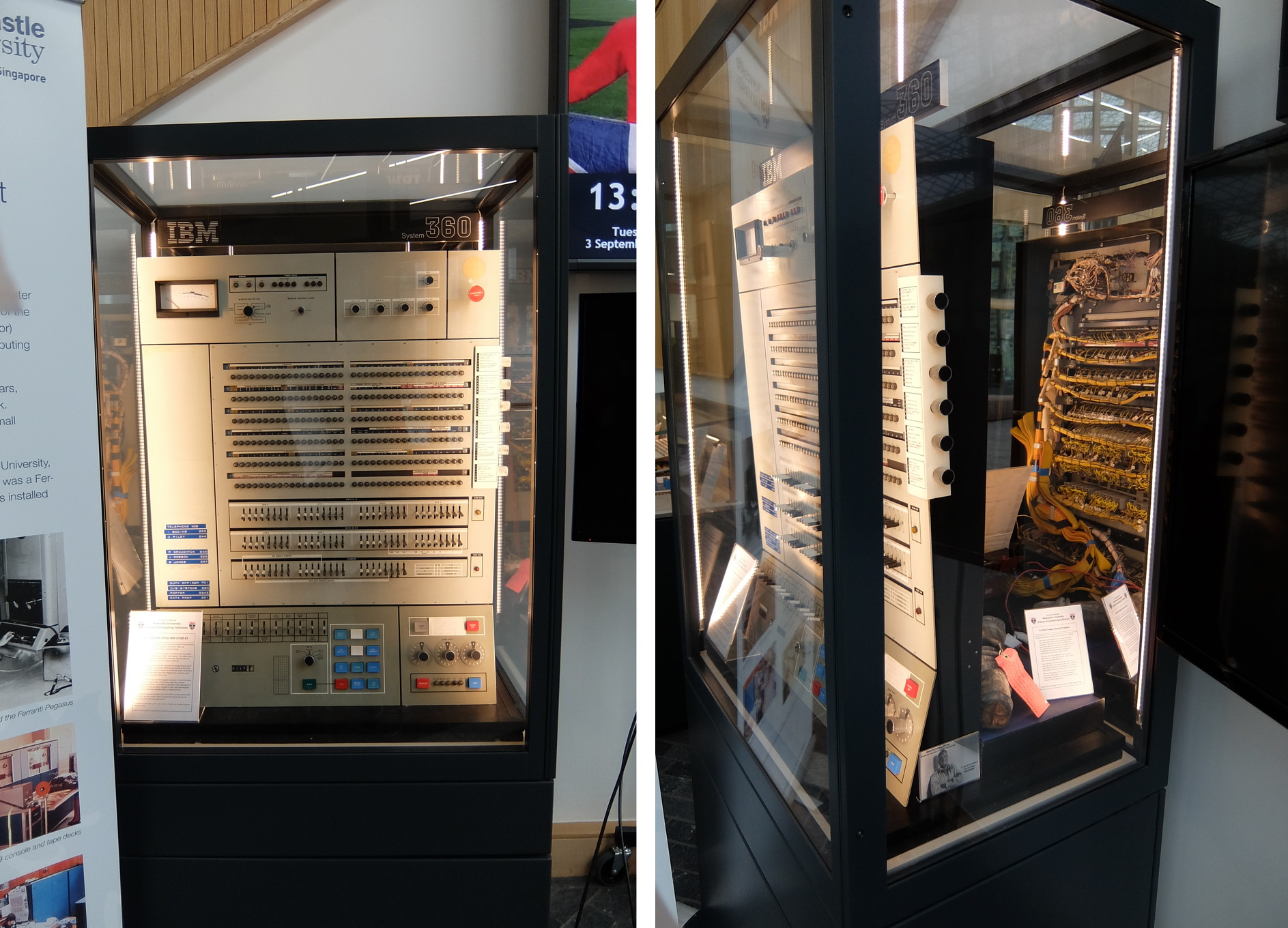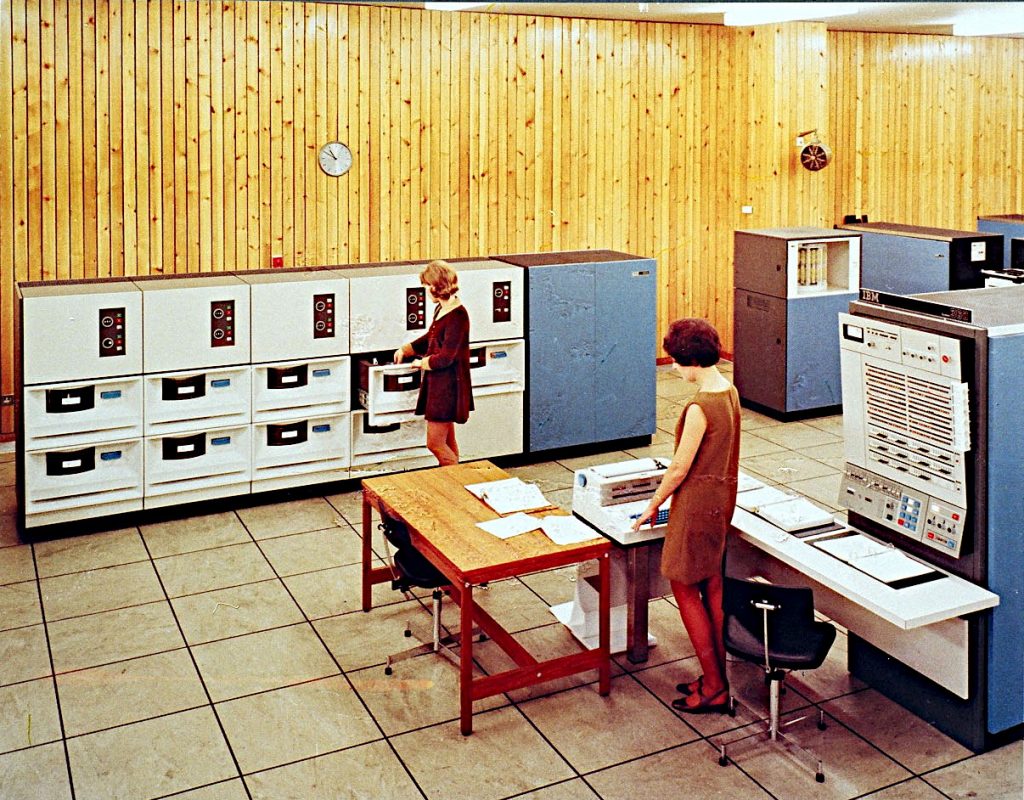Celebrating 50 years of campus-wide computing
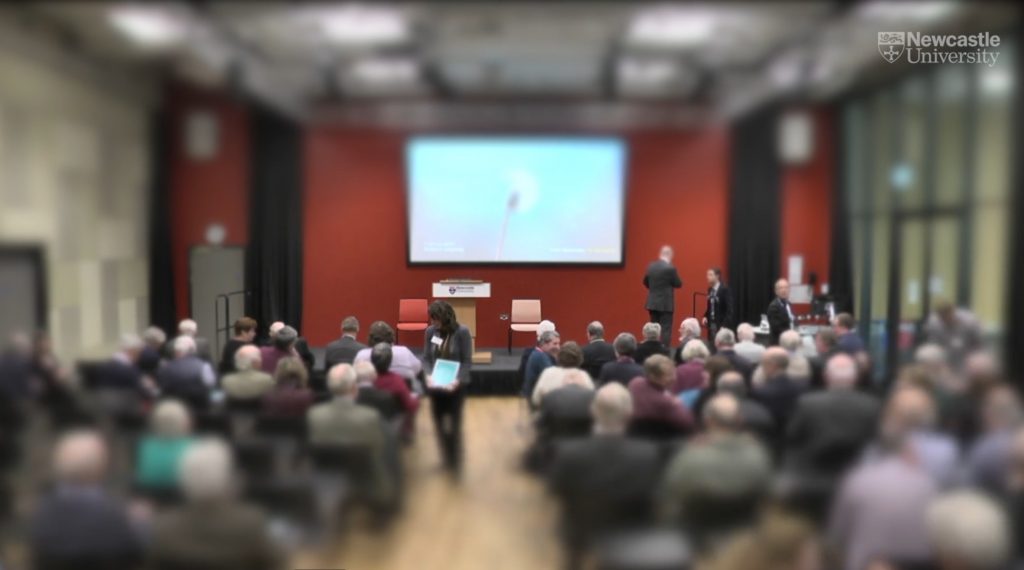
A personal view of the event, from John Law [1]. This article has six footnotes, which are “a layperson’s guide” to some aspects of the story.
On 13th June 2019 we staged the official opening of the first displays of the Collection. We had invited about 60 UK computing specialists to attend, but in the end – word having got around – we welcomed over 100 people.
“Mighty oaks from little acorns grow“: NUHCC has as its ultimate aim a Collection which will exhibit the use of technology in higher education – specifically computing at Newcastle University. Roger Broughton planted the acorns, with his unique collection of computing artefacts gathered over the Computing Laboratory’s notable history. Inauguration Day showed that NUHCC is now a sapling!
The day proved to be a fantastic success, even though (as our past Chairman Jon Dowland had said) as amateur part-timers we were really “punching above our weight” in aspiring to organise an event like this.
Everything went to plan: from reception and catering, the filming of the speakers, the flashing lights of the 360’s Console(!), the 3D-printed model of the 360-67 Computer Room, the video show, the production of a 50-page “souvenir handbook”, the timetable … Our Chair, Troy Astarte, closed the final session by saying “It’s all gone much better than my worst nightmares! And even better than my best dream!”.
There is a professional sheen to the display cabinets [2], as there was to this whole day, which reflects well upon NUHCC, and does proper honour to our backers. I will not try to name all those who made it such a success … although I would like to single out Sara (Bellwood), who did all the organisational administration, having had little (or no?) previous relevant experience. “Admin” becomes absolutely crucial when you decide to put on an event like this, and it is where the stress is most acute: everything worked seamlessly on the day!
What was it all about?
We had been working towards this Exhibition from the first days of taking over Roger Broughton’s Collection, at the start of 2017. The posters for the event began with this paragraph:
“Two of the most significant developments in the 65-year history of computing at Newcastle University were the acquisition of the giant IBM 360-67 mainframe computer in 1967 and subsequently, in 1969, the adoption of the Michigan Terminal System. MTS was the operating system which enabled the full potential of the extraordinary Model 67 to be realized.”
What was that “extraordinary Model 67”, again?
In short, IBM’s 360 Model 67 was an experimental machine, which, because of the innovation of virtual memory, had the potential to offer “time-sharing”, or “multi-tasking” – it could simultaneously process several tasks at once. [3]
Thanks to great foresight – and furiously hard work – Newcastle University’s Computing Laboratory found themselves at the cutting edge of 1960s computing by succeeding in their bid to have a 360 Model 67 installed here in August 1967; it was one of only two in Europe. An entire organization “NUMAC”[4] was created to run the behemoth.
So in 1967 the Laboratory had (momentarily!) the biggest computer in the country.
And what’s more it was made by IBM, not ICL (the Government’s preferred supplier).
And what’s more, it was an IBM System/360 Model 67: a unique computer because of its time-sharing capabilities.
And what’s more, some of those “tasks” could be people, communicating with the machine in real time via computer terminals.
Another great leap of faith was made just over a year later in 1969: IBM’s own time-sharing operating system, TSS, was simply not working, and so NUMAC decided to run the mainframe service under the Michigan Terminal System MTS [5]. (Hence the title for this event of “50 years of campus-wide computing”.)
This was a very exciting time, and the possibilities for the future were fizzing.
In his introductory talk on June 13th, Professor John Fitzgerald told us:
“It is a story of Computing, Communications, and Cooperation”.
Speakers
Video: Our six speakers were filmed by the University’s Digital Media Services (part of NUIT), who have tremendous professional experience. The video is now available at
https://vimeo.com/353896736 (Subtitles have been added.)
The video is two hours long! But it’s well worth dipping into: four of the six speakers are genuine “legends in their own lifetime”: see the brief portraits below.
Video timings are shown with each speaker. Note that the video has subtitles; you can download a PDf of the complete transcript from the NUHC Repository.
Welcome, from Professor John Fitzgerald, and Troy Astarte
Professor Fitzgerald, Head of the School of Computing, gave what I personally felt was an object lesson in “How to give a short talk”: an invigorating and inspiring five-minute introduction which primed us perfectly for the afternoon. (As many of us know: it is often harder to give a short talk, than a long one!)
The Chair of the NUHCC Committee, Troy Astarte then gave a 2-minute introduction to the afternoon’s speakers. (Congratulations, Troy, on doing a stellar job of running the day’s proceedings!)
Professor Ewan Page “How the System/360-67 came to Newcastle”
Video timing: 0:06:31 – 0:25:20
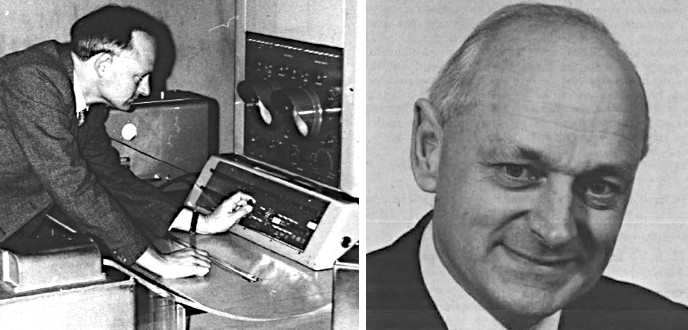
Professor Page was the first Director of the Computing Laboratory (he later became Vice Chancellor of Reading University). He told the fascinating story of how Newcastle came to acquire the 360-67. In his preamble, he indicated how he is a direct link with the very first digital computers of the 1940s [6].
Professor Page is now 90 years old, and I have to admit that I was expecting to meet a faded, shrunken version of the man who was my boss almost 50 years ago. Not a bit of it: he is as tall and robust as he ever was, and his charisma is still like a forcefield! A great speaker and, to be honest, he made me feel rather old! 😀
There is a great biography of Professor Page at https://archivesit.org.uk/interviews/ewan-page/
Mike Alexander, University of Michigan “The Michigan Terminal System:
its early history and significance”
0:25:39 – 1:04:00
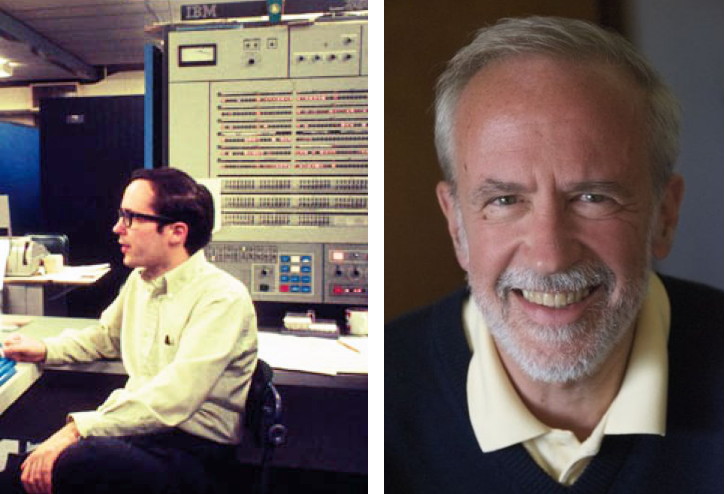
Mike and his wife Suzan came all the way from Michigan just for us.
One of the creators of the Michigan Terminal System, Mike features twice in Wikipedia: in the entry for the IBM 360-67, and in the entry for MTS. Modest and unassuming in all he says about the past, Mike is “MTS”. It was wonderful for all his old friends here at Newcastle to meet him again. His talk on the history of MTS, and the MTS Community, was the highlight of the afternoon, coming as it did from “the horse’s mouth”.
Elizabeth Barraclough, First Director of the Computing Service
“Getting the S/360 to the Users”
1:04:00 to 1:22:00
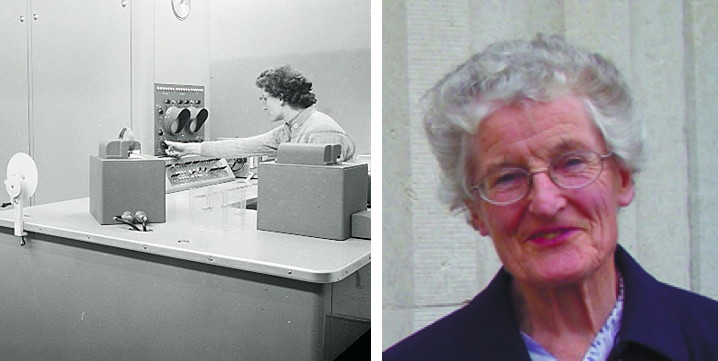
Elizabeth was recruited by Professor Page in 1957, when she started as “The Computer Operator”[see note below] for the Computing Laboratory’s first computer, the Ferranti Pegasus. (It was also the first computer, of any kind, in the North East of England.)
Elizabeth was made the first Director of NUMAC in 1969, retiring in 1993. Speaking for myself, she was the best manager I have known, combining sharp intellect, and technical acumen, with human sensitivity and a passion for what is right.
And – let us never forget – she was a female pioneer in what was very definitely a man’s world (in everything, not only computing!).
Note: Terminology has changed: would you say that the pilot is part of the cabin crew? A Pegasus “Computer Operator” was a skilled programmer, and also a hands-on technical expert.
Professor Brian Randell “From a Basement to the Cloud”
1:22:00 – 1:46:00
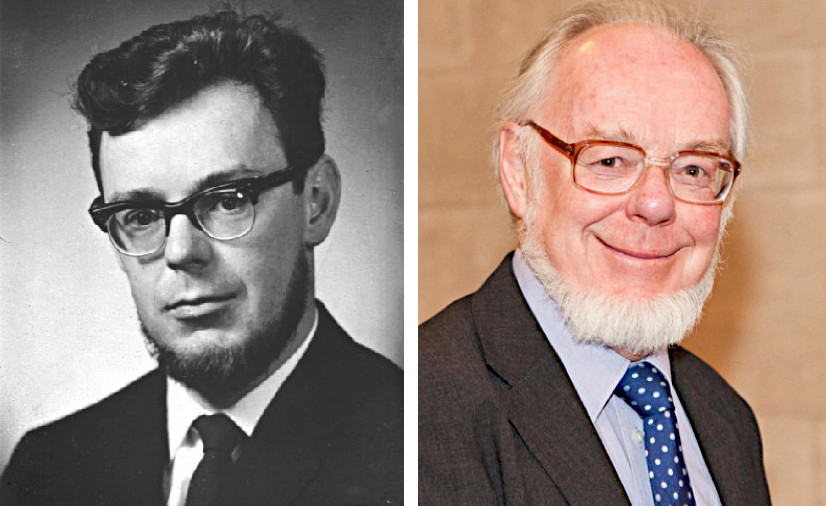
And our own Professor Brian Randell: a Legend who’s still working at the School he joined 50 years ago! He told us how he came to Newcastle in 1969, having previously been head-hunted to IBM’s Research Center at Yorktown Heights. He was with IBM for five years, before he was drawn back to the UK by what he could see were ground-breaking developments at Newcastle – appreciating them more than most because of his inside knowledge at the heart of IBM.
We are extremely fortunate to have him as the driving force behind NUHCC, thanks to his vast experience in so many aspects of computing, in the History of Computing, and in academia as a whole. Again, a great biography appears at https://archivesit.org.uk/interviews/brian-randell/
Jason Bain, Deputy Director of NUIT “IT Services: Past, Present and Future”
1:46:00 – 1:59:00
Jason closed the show by giving us a comparative run-down of how the computing services, and in particular networks, have developed in the 50 years since MTS first ran at Newcastle. Historically, because of NUMAC’s “split-site” (Newcastle-Durham), and also because of the unique terminal service being operated, the Computing Laboratory was a real pathfinder in networking, in the 1970s, leading to us using the Internet “before it was the Internet” (see the link at the end of this article).
I wish to add, as an aside, that Jason has personally made sure that NUHCC has received a great deal of support from NUIT, for which we are deeply grateful: sine qua non.
The unveiling of the three display cabinets
Finally, after the talks, we gathered for the unveiling of the showcases by various luminaries: Marge Craig (wife of Roger Broughton, whose vast collection started this whole phenomenon); the Vice Chancellor (no less); and very fittingly Professor Brian Randell … who is himself a true phenomenon.
Please note that a special web page has been devoted to the two 360-67 cabinets.
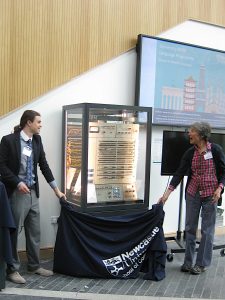
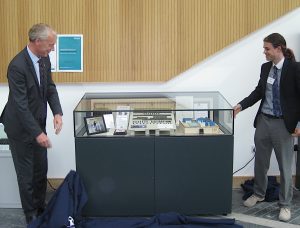
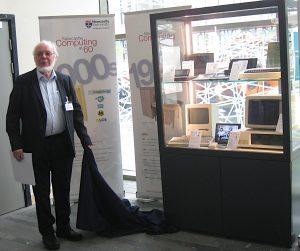
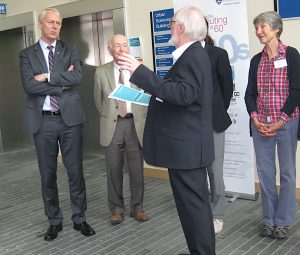
The gentleman standing next to the VC really is a gentleman: Dick Woodman was the IBM Engineer assigned to look after Newcastle’s IBM mainframe(s). He was highly respected, and held in great affection, by all those who encountered him: another distinguished visitor on this day.
The Celebration Handbook
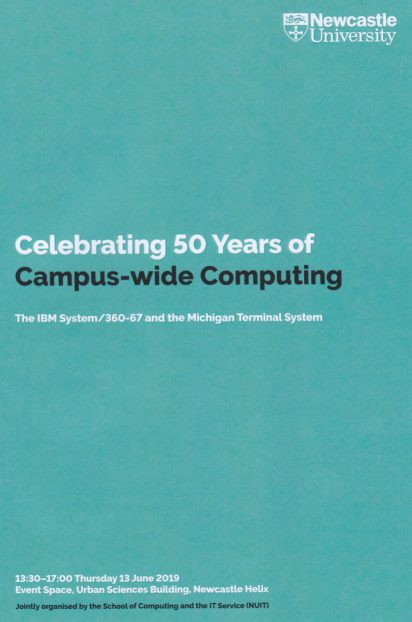
The 50-page handbook which was produced for the event is a collection of short, informative articles about why the Celebration took place, about NUMAC, the computers, MTS, the notion of virtual memory (including a seminal paper on time sharing), and a tribute to Roger Broughton. The full contents appear in the NUHC Catalogue, which also has a link to a PDF (17MB) of the whole publication.
Links
Handbook for the Inauguration Event, 13 June 2019: https://nuhc.ncl.ac.uk/view/460
The video of the speakers: https://vimeo.com/353896736
Roger Broughton’s Virtual Museum of Computing Artefacts
(actually, now, an artefact in itself, but brilliant): https://moca.ncl.ac.uk/
NUHCC (Newcastle University Historical Computing Collection – the Catalogue of Roger’s collection: https://nuhc.ncl.ac.uk/
The CS-History Historical Collection – the home page of this project: https://blogs.ncl.ac.uk/cs-history/hardware/
The Computing Laboratory’s 40th Anniversary website, 1997:
http://history.cs.ncl.ac.uk/anniversaries/40th/
The MTS Archive: a treasure trove for researchers, both personal and CS-technical http://archive.michigan-terminal-system.org/
“Fifty years ago, computers began to talk to each other …“: an impressive 1-page “layman’s history” of The Internet, published 16/11/2019 by The Week, and kindly provided by them to us for this purpose: view here.
Footnotes
[1] Author of this article
John is one of the volunteer “curators” who make up the Newcastle University Historical Computing Committee. He worked for the Computing Laboratory from 1971 until 2009 in user education. Back to start
[2] The NUHCC display cases
In 2017 we set about acquiring, through the great efforts of certain members of the Committee led by Will Blewitt our then-Chairman, three museum-quality display cases from ClickNetherfield (“By Royal Appointment”).
Some thousands of pounds had been generously provided by The Catherine Cookson Foundation: all of it, plus more from other sources, was spent on these three showcases. They arrived in 2018, and were first used for the 60th anniversary of the Computing Laboratory (now the School of Computing).
However, the display cases had been bought specifically with this System/360 exhibition in mind, and one in particular was made with dimensions to house the centrepiece of the display, the CPU Console from the IBM 360-67 mainframe.
Back to where you were
[3] How did Newcastle get a Model 67?
Today, unimaginable computing power is instantly available at every conceivable turn in life: it is easy to forget that in the 1960s a computer, although a miraculous machine, did one thing at a time (albeit in microseconds), and communicated with nothing and nobody, apart from its own I/O channels and (occasionally) its operators.
The IBM S/360-67 marked an enormous leap forward for computing because of its time-sharing capabilities. Newcastle’s 360-67 cost about £1,000,000 in 1967, which in raw terms is about £16,000,000 in 2019.
Government funds had become available because of the publication of “The Flowers Report” in January 1966, which basically had said: “We must get our University researchers better equipped with these new computing machines: make some money available!”.
Newcastle’s bid was extraordinarily bold: firstly, they made a combined bid with Durham (70%-30%); secondly, they asked for this extremely powerful – and expensive – machine; thirdly, the computer they were asking for was so advanced as to be virtually experimental; and fourthly, it was made by the American IBM, as opposed to the British ICL, the Government’s preferred supplier.
That the bid was successful owed
a lot to three factors: foremost, the personality and clear-sightedness of the
Director of the Computing Laboratory, Professor Page; then, the obvious willingness
of the two Universities (17 miles apart) to work together; and (as Professor
Page told us on 13th June), the fact that IBM themselves were
extremely keen to make it all work.
(Perhaps another factor was that
Claremont Tower, which had just been opened in 1966, had had an enormous
computer room purpose-built into its Sub-Basement!)
A condition of NUMAC getting the funds for the 360-67 was that they were to provide remote services to other Universities who wished to use an IBM operating system; the biggest user was Edinburgh University’s Regional Computing Centre.
The 360 Model 67 and MTS proved the theories about Virtual Memory (see, e.g., the paper in the Celebration Handbook) so successfully that IBM had to include it in the design of their great Series 370 mainframes of the 1970s (see the Wikipedia article).
IBM continued to be very closely involved with the Computing Laboratory for a couple of decades, in terms of research and sponsorship, as well as technical cooperation.
Back to where you were
[4] NUMAC
Newcastle and Durham created a new organisation, Northumbrian Universities Multiple Access Computer, whose sole purpose was to run the 360-67. At first, NUMAC was 70% Newcastle and 30% Durham; later, Newcastle Polytechnic joined the organisation.
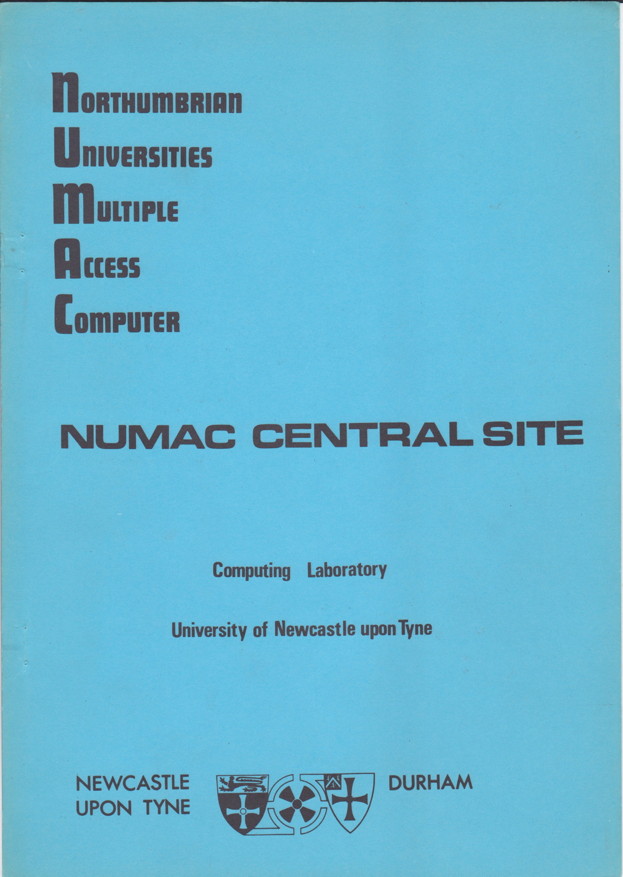
Newcastle had been “King’s College of Durham University” until 1963, when it was given its own University status. All of Durham’s considerable scientific and engineering activities took place at King’s College – Newcastle upon Tyne was an engineering centre of the world (Vickers-Armstrongs, Swan-Hunter, Parsons … mining, geology, shipbuilding, engineering …). Hence, Newcastle University sprang forth fully fledged as a science-based University in 1963.
Back to where you were
[5] MTS – The Michigan Terminal System
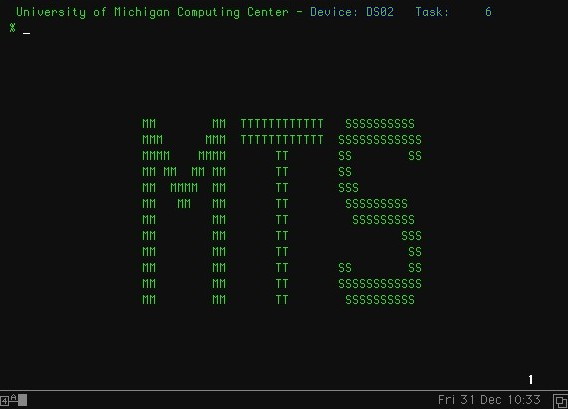
The Model 67 was so new that IBM had built only a few experimental examples, and they were still writing an operating system for it when deliveries started. That system was called TSS (Time Sharing System).
Aside: when a Model 360-67 wasn’t experimenting with TSS, it was running a conventional “batch” operating system, IBM’s OS/MVT.
One of the main lobbyists to IBM, in convincing them to make a time-sharing version of the System 360 series, had been the University of Michigan. UM were the lead site in receiving and testing the 360-67 – and they were frustrated by IBM’s TSS. UM designed their own operating system for the machine: the Michigan Terminal System.
By the time Newcastle had had their 360-67 for a year, they too had discovered frustrations with TSS. Newcastle had long had cordial relations with UM, and in 1969 they decided that they too would move to using MTS. (Hence the title for this event: “50 Years of Campus-wide Computing”).
MTS proved to be a wonderful success: powerful, written with intimate knowledge of the hardware, and of the requirements of universities (as opposed to business), and beautifully easy to use; problems could be raised directly with the authors of software, and ensuing dialogues would be carried out over early versions of email and discussion forums (decades before “the Internet” appeared).
There were only seven institutions (three in the USA, three in Canada, and Newcastle/Durham in Europe), who used the 360-67 and MTS: the community was as tight-knit as a family. Annual Workshops were organised, where the staff from all the institutions met for a few days in densely organised sessions to discuss ongoing projects and future developments; and to have fun!
MTS ran the NUMAC mainframes for 23 years from 1969 until 1992 (the end of the mainframe era).
Incidentally: in 2012 MTS was ported to a Raspberry Pi, by Richard Chycoski, formerly of UM. The image of that Raspberry Pi, compared to an image of a 360-67 in its vast, dedicated computer room, is a stunning illustration of what Jason Bain talked about on 13th June 🙂
Back to where you were
[6] Professor Page – a direct link with the first digital computers
Professor Page used EDSAC for his research when studying for his PhD. EDSAC ran its first program in 1949: it was “the second electronic digital stored-program computer to go into regular service” (see the fascinating Wikipedia entry). This experience ultimately put him in the front rank when applications were invited for the post of Director at Durham University’s new “Computing Laboratory” in 1957.
Again – you are referred to that great biography of Professor Page at https://archivesit.org.uk/interviews/ewan-page/
Back to where you were


